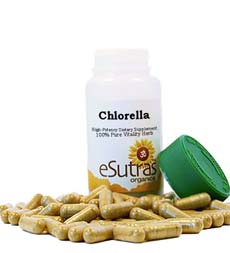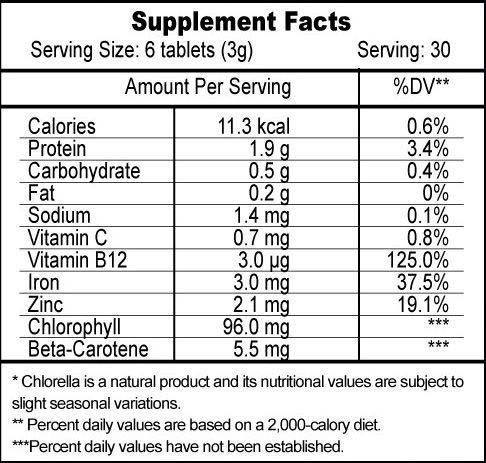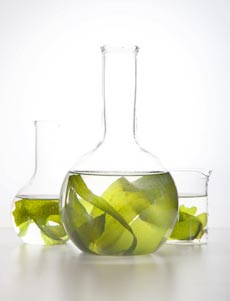|
|
Chlorella: A Nutritional Supplement Dissected Threadbare

Chlorella
is a genus of single-cell green algae, belonging to the phylum
Chlorophyta. It is spherical in shape, about 2 to 10 μm in diameter, and is
without flagella. Chlorella contains the green photosynthetic pigments
chlorophyll -a and -b in its chloroplast. Through photosynthesis, it multiplies
rapidly, requiring only carbon dioxide, water, sunlight, and a small amount of minerals to
reproduce.
Chlorella is a genus of single-cell green algae, belonging to the phylum
Chlorophyta. It is spherical in shape, about 2 to 10 μm in diameter, and is
without flagella. Chlorella contains the green photosynthetic pigments
chlorophyll -a and -b in its chloroplast. Through photosynthesis, it multiplies
rapidly, requiring only carbon dioxide, water, sunlight, and a small amount of minerals to
reproduce.
Most of the chlorella that is available in the U.S. is grown in Japan or Taiwan.
It is processed and made into tablets and liquid extracts. These extracts
contain "chlorella growth factor," which is described as a water-soluble extract
of chlorella containing chemicals including amino acids, peptides, proteins, vitamins,
sugars, and nucleic acids. Be aware that chlorella products can vary
significantly depending on the way �the crop� used to make them was cultivated,
harvested, and processed. Investigators have found that dried preparation of
chlorella can contain from 7% to 88% protein, 6% to 38% carbohydrate,
and 7% to 75% fat.
As a medicine, chlorella is used for preventing cancer, reducing radiation
treatment side effects, stimulating the immune
system,
improving response to flu vaccine, increasing white blood cell counts
(especially in people with HIV infection or cancer), preventing colds,
protecting the body against toxic metals such as lead and mercury, and slowing
the aging process. Chlorella is also used to increase �good� bacteria in the
intestine in order to improve digestion;
and to help treat ulcers, colitis, Crohn's disease, and diverticulosis.
Some people also use chlorella for the prevention of stress-related ulcers;
treatment of constipation,
bad breath, and hypertension;
as an antioxidant; to reduce cholesterol; to increase energy; to detoxify the
body; and as a source of magnesium to promote mental health, relieve premenstrual
syndrome (PMS),
and reduce asthma attacks. It is also used for fibromyalgia.
Chlorella is applied to the skin for treating skin ulcers, rashes caused by
radiation treatment, and a sexually transmitted disease called trichomoniasis.
Chlorella is a good source of protein, fats, carbohydrates, fiber, chlorophyll,
vitamins, and minerals. The cell wall of chlorella must be broken down before
people can digest it.
The name Chlorella is taken from the Greek chloros, meaning green, and the Latin
diminutive suffix ella, meaning small. German biochemist and cell physiologist
Otto Heinrich Warburg, awarded with the Nobel Prize in Physiology or Medicine in
1931 for his research on cell respiration, also studied photosynthesis in
Chlorella. In 1961, Melvin Calvin of the University of California received the
Nobel Prize in Chemistry for his research on the pathways of carbon dioxide
assimilation in plants using Chlorella. In recent years, researchers have made
less use of Chlorella as an experimental organism because it lacks a sexual
cycle and, therefore, the research advantages of genetics are unavailable.
Many people believe Chlorella could serve as a potential source of food and
energy because its photosynthetic efficiency can, in theory, reach 8%,
comparable with other highly efficient crops such as sugar cane.
It is an attractive potential food source because it is high in protein and
other essential nutrients; when dried, it is about 45% protein, 20% fat, 20%
carbohydrate, 5% fibre, and 10% minerals and vitamins. Mass-production
methods are now being used to cultivate it in large artificial circular
ponds. It is also abundant in calories, fat, and vitamins.
When first harvested, Chlorella was suggested as a "dirt-cheap" protein
supplement to the human diet. Advocates sometimes focus on other supposed
health benefits of the algae, such as claims of weight
control, cancer prevention, and immune system support.
Under certain growing conditions, Chlorella yields oils that are high in
polyunsaturated fats�Chlorella minutissima has yielded EPA at 39.9% of total
lipids. One small (35 participant) study suggested Chlorella supplementation has
a positive effect on the reduction of dioxin levels in breast
milk and
it may also have beneficial effects on nursing infants by increasing the IgA
levels in breast milk.
To cope with the upcoming post-war population boom in the United States and
elsewhere, researchers decided to tap into the unexploited sea resources.
Initial testing by the Stanford Research Institute showed Chlorella (when
growing in warm, sunny, shallow conditions) could convert 20 percent of solar
energy into a plant that, when dried, contains 50 percent protein. In addition,
Chlorella contains fat and vitamins. The plant's photosynthetic efficiency
allows it to yield more protein per unit area than any other plant�one scientist
predicted 10,000 tons of protein a year could be produced with just 20 workers
staffing a one-thousand-acre (4-square kilometer) Chlorella farm. The pilot
research performed at Stanford and elsewhere led to immense press from
journalists and newspapers, yet did not lead to large-scale algae production.
Chlorella seemed like a viable option because of the technological advances in
agriculture at the time and the widespread acclaim it got from experts and
scientists who studied it. Algae researchers had even hoped to add a neutralized
Chlorella powder to conventional food products, as a way to fortify them with
vitamins and minerals.
When the preliminary laboratory results were published, the reaction of
scientific literature backed the possibilities of the supposed superfood. Science
News Letter praised the optimistic results in an article entitled "Algae to Feed
the Starving." John Burlew, the editor of the Carnegie Institution of Washington
book Algal Culture-from Laboratory to Pilot Plant, stated, "the algae culture
may fill a very real need," which Science News Letter turned into "future
populations of the world will be kept from starving by the production of
improved or educated algae related to the green scum on ponds." The cover of the
magazine also featured Arthur D. Little's Cambridge laboratory, which was a
supposed future food factory. A few years later, the magazine published an
article entitled "Tomorrow's Dinner", which stated, "There is no doubt in the
mind of scientists that the farms of the future will actually be factories."
Science Digest also reported, "common pond scum would soon become the world's
most important agricultural crop." At least in the decades that followed, algae
was not cultivated on nearly that scale, however.
Since the growing world food problem of the 1940s was solved by better crop
efficiency and not from a "super food," Chlorella has not seen the kind of
public and scientific interest that it had in the 1940s. Chlorella can still be
found today from companies promoting its "super-food" effects.
In the end, scientists discovered that Chlorella would be much more difficult to
produce than previously thought. The experimental research was carried out in
laboratories, not in the field. In order to be practical, the entire batch of
algae grown would have to be placed either in artificial light or in shade to
produce at its maximum photosynthetic efficiency. Also, for the Chlorella to be
as productive as the world would require, it would have to be grown in
carbonated water, which would have added millions to the production cost. A
sophisticated process, and additional cost, was required to harvest the crop,
and, for Chlorella to be a viable food source, its cell walls would have to be
pulverized. The plant could reach its nutritional potential only in
highly-modified artificial situations. Another problem was developing
sufficiently palatable food products from Chlorella.
Although the production of Chlorella looked promising and involved creative
technology, it has not to date been cultivated on the scale some had predicted.
It has not been sold on the scale of Spirulina,
soybean products, or whole-grains. Costs have remained high, and Chlorella has
for the most part been sold as a health food, for cosmetics, or as animal feed.
After a decade of experimentation, studies showed that, following exposure to
sunlight, Chlorella captured just 2.5 percent � not much better than
conventional crops. Chlorella, too, was found by scientists in the 1960s to be
impossible for humans and other animals to digest in its natural state due to
the tough cell walls encapsulating the nutrients, which presented further
problems for its use in American food production.
In 1965, the Russian CELSS experiment BIOS-3 determined that 8 square meters of
exposed chlorella could remove carbon dioxide and replace oxygen within the
sealed environment for a single human. The chlorella was grown in vats
underneath artificial light.
Claims of health and healing effects of Chlorella

Because of its unique ability to bind with mercury, lead, and cadmium, Chlorella
vulgaris has become increasing popular as a heavy metal "detoxifier". Studies
demonstrate that it has a superior ability to (safely) draw toxic metals that
accumulate in the gut and intestinal tract. Like blue-green algae, clinical
studies on Chlorella suggest effects including polychlorinated dibenzodioxins
detoxification in humans and animals, healing from radiation exposure in animals
and the ability to reduce high blood pressure, lower serum cholesterol levels,
accelerate wound healing, and enhance immune functions in humans.
Chlorella has been found to have anti-tumor properties when fed to mice. Another
study found enhanced vascular function in hypertensive rats given oral doses of
chlorella. However, the use of Chlorella for healing effects has received
criticism.
There is insufficient evidence for:
Radiation or chemotherapy side effects. Early research suggests chlorella
tablets plus chlorella liquid extract might help people with a type of brain
cancer called glioma better tolerate chemotherapy and radiation treatments,
possibly by boosting the immune system. Unfortunately, chlorella doesn�t seem to
slow the progression of the cancer or improve survival.
Fibromyalgia. Some people with fibromyalgia say they feel better when they take
chlorella tablets plus a liquid extract containing malic acid daily for two
months.
-
-
Colds.
-
Crohn's disease.
-
Ulcerative colitis.
-
Ulcers.
-
-
Bad breath.
-
-
High cholesterol.
-
Other conditions.
-
More evidence is needed to rate the effectiveness of chlorella for these
uses.
Health concerns of Chlorella
 A
2002 study showed that Chlorella cell walls contain Lipopolysaccharides, an
endotoxin found in Gram-negative bacteria that affects the immune system and may
cause inflammation. However, more recent studies have found that the
Lipopolysaccharides in organisms other than Gram-negative-bacteria, for example
in cyanobacteria, are considerably different from the Lipopolysaccharides in
Gram-negative bacteria. Remarkably, a 2010 study found that Chlorella contains a
peptide, known as Chlorella-11, that actually inhibits the inflammation caused
by Lipopolysaccharides from Gram-negative-bacteria. A
2002 study showed that Chlorella cell walls contain Lipopolysaccharides, an
endotoxin found in Gram-negative bacteria that affects the immune system and may
cause inflammation. However, more recent studies have found that the
Lipopolysaccharides in organisms other than Gram-negative-bacteria, for example
in cyanobacteria, are considerably different from the Lipopolysaccharides in
Gram-negative bacteria. Remarkably, a 2010 study found that Chlorella contains a
peptide, known as Chlorella-11, that actually inhibits the inflammation caused
by Lipopolysaccharides from Gram-negative-bacteria.
Chlorella is possibly safe when used short-term (up to 2 months). The most
common side effects include diarrhea, nausea, gas (flatulence), green
discoloration of the stools, and stomach cramping, especially in the first week
of use.
Chlorella has caused serious allergic reactions, including asthma and
other dangerous breathing problems. Chlorella can cause skin to become extra
sensitive to the sun. Wear sunblock outside, especially if you are
light-skinned.
Special Precautions & Warnings:
Pregnancy and breast-feeding: Not enough is known about the use of chlorella
during pregnancy and breast-feeding. Stay on the safe side and avoid use.
Iodine sensitivity: Chlorella can contain iodine. Therefore, chlorella might
cause an allergic reaction in people sensitive to iodine.
Weak immune system (immunodeficiency): There is a concern that chlorella might
cause �bad� bacteria to take over in the intestine of people who have a weak
immune system. Be careful with chlorella if you have this problem.Chlorella
might cause the immune system to become more active, and this could increase the
symptoms of autoimmune diseases. If you have one of these conditions, it�s best
to avoid using chlorella.Chlorella might increase the immune system. By
increasing the immune system, chlorella might decrease the effectiveness of
medications that are used to decrease the immune system.
Dated 26 January 2013
|
|
|
|
|









